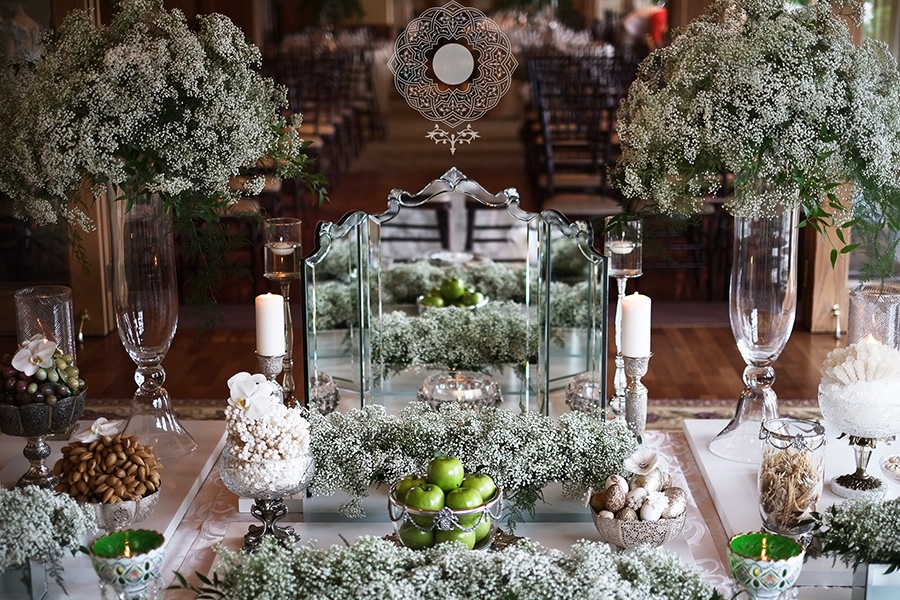No products in the cart.
Return To ShopSofreh Aghd London- Table of Wedding
Sofreh Aghd London
Over the past few years our number of Persian Ceremonies has increased with weddings held at the Landmark and The dorchester this year with some of the most beautiful brides.
We had the pleasure of providing our decor services to make them a splendid affair.
We are asked more and more to be able to provide the full Sofreh so for next year this will be one of our hire pieces.
With that said- we thought we should showcase to our readers what each part of the Sofreh means..
 Here goes!
Here goes!
Within recent there has been a rise of traditional Persian weddings filtered across the net. Persian weddings are elaborate to say the least but the ceremony itself is extremely sentimental. A sofreh Aghd is a Persian wedding ceremony spread that couples legal marriage and ceremonial traditions into one. It’s a mixture of food and decorations. The ceremony has been practised for thousands of years and have become far more elaborate in recent years. Iranians have quite a diverse religious backgrounds so the sofreh aghd is a chosen practiced regardless of faith. Everything laid on the spread is a symbol to show an element of the life and marriage between the couple.

The 7 Pastries
Noghl, Baklava, Toot (Persian marzipan),Nann-e Berenji (Rice cookies), nann-ebadami (Almond cookies) nan-e nokhodchi (chickpea cookie) and Sohan –e Asali (Saffron almond brittle).
The 7 herbs
Khashkhash (poppyseed), Berey (rice) sabzi Khosk, salt, roziyaneh (nigella seeds), Angelica, chayi (black tea leaves) & kondor (Frankincense)
These would be placed on a spread and served to the guests at the ceremony
*Mirror of Fate and two candelabras symbolises light and fire.
The bride must enter with the veil covering her face only when she sits next her bridegroom may the bride remove her veil. (The first thing the bridegroom should see is his wife to be reflection)
The blessed bread
The blessed bread is specially baked bread with calligraphy on it “Nan-o Panir-o sabzi” with Persian feta cheese and greens. These are placed on the spread to symbolise the basic food that is needed to sustain life. This is also eventually served to the guests.
Eggs, Almonds, Walnuts
Decorated eggs, almonds, walnuts and hazelnuts are symbols of fertility.

The Coins
A bowl of coins is a symbol of wealth and prosperity for the couple. Sacred text such as The Avesta, Qur’an, Bible or Torah is placed in front of the couple. Some couples families choose to place a poetry book also on the spread.
The heavenly fruit

Apples, pomegranates, grapes, Persian rose ( a cup of rose water and a rose extracted from the Got-e Mohammed (Mohammadam Flower) this is used to perfume the room. Shakh – e Nabit (a bowl made out of rock candy is also placed on the spread including honey. *Immediately after marriage the couple dip a pinkly finger into the cup of honey and feed it to each other. A familiar scene in religious ceremonies is the Esphand & frankincense sprinkled on to a brazier holding hot coals producing a smoke to ward off evil spirits.
Prayer Rug (Jayeh Namaz) or a Termeh is placed in the center of the spread. This is a symbol to remind the couple about the importance to pray to god. Small cubes of clay with a prayer written on them. Mohr and a rosary (tasbih) is also placed on the spread.
A scarf or shawl made out of fine fabric or silk is placed over the couples head by unmarried female relatives (bridesmaids). The couple at this point will be sitting next to the sofreh aghd. Hard candy will also be ground over the couples head by a happy married female relative (maid of honor) (Non muslim families can forfeit this part of the ceremony













Leave a reply